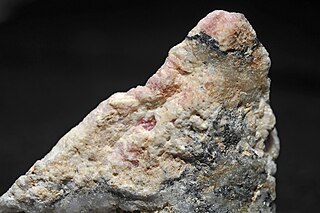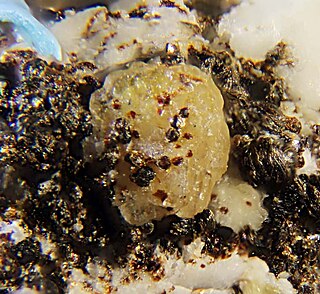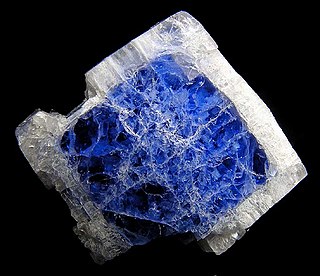
Tugtupite is a beryllium aluminium tectosilicate. It also contains sodium and chlorine and has the formula Na4AlBeSi4O12Cl. Tugtupite is a member of the silica-deficient feldspathoid mineral group. It occurs in high alkali intrusive igneous rocks.

Natrolite is a tectosilicate mineral species belonging to the zeolite group. It is a hydrated sodium and aluminium silicate with the formula Na2Al2Si3O10·2H2O. The type locality is Hohentwiel, Hegau, Germany.

Aegirine is a member of the clinopyroxene group of inosilicate minerals. It is the sodium endmember of the aegirine–augite series. It has the chemical formula NaFeSi2O6, in which the iron is present as the ion Fe3+. In the aegirine–augite series, the sodium is variably replaced by calcium with iron(II) and magnesium replacing the iron(III) to balance the charge. Aluminum also substitutes for the iron(III). Acmite is a fibrous green-colored variety.

Abenakiite-(Ce) is a mineral of sodium, cerium, neodymium, lanthanum, praseodymium, thorium, samarium, oxygen, sulfur, carbon, phosphorus, and silicon with a chemical formula Na26Ce6(SiO3)6(PO4)6(CO3)6(S4+O2)O. The silicate groups may be given as the cyclic Si6O18 grouping. The mineral is named after the Abenaki, an Algonquian Indian tribe of New England. Its Mohs scale rating is 4 to 5.

Sugilite ( SOO-gə-lyte, -jee-) is a relatively rare pink to purple cyclosilicate mineral with the complex chemical formula KNa2(Fe, Mn, Al)2Li3Si12O30. Sugilite crystallizes in the hexagonal system with prismatic crystals. The crystals are rarely found and the form is usually massive. It has a Mohs hardness of 5.5–6.5 and a specific gravity of 2.75–2.80. It is mostly translucent. Sugilite was first described in 1944 by the Japanese petrologist Ken-ichi Sugi (1901–1948) for an occurrence on Iwagi Islet, Japan, where it is found in an aegirine syenite intrusive stock. It is found in a similar environment at Mont Saint-Hilaire, Quebec, Canada. In the Wessels mine in Northern Cape Province of South Africa, sugilite is mined from a strata-bound manganese deposit. It is also reported from Liguria and Tuscany, Italy; New South Wales, Australia and Madhya Pradesh, India.

Steacyite is a complex silicate mineral containing thorium and uranium; formula Kvariable(Ca,Na)2(Th,U)Si8O20. It forms small brown or yellow green crystals, often cruciform twinned crystals. It is radioactive. It was discovered at Mont-Saint-Hilaire, Quebec in 1982 and is named after Harold Robert Steacy (1923–2012), mineralogist.
Zircophyllite is a complex mineral, formula (K,Na)3(Mn,Fe)2+7(Zr,Ti,Nb)2Si8O24(OH,F)7. It crystallizes in the triclinic – pinacoidal crystal class as dark brown to black micaceous plates. It has perfect 001 cleavage, a Mohs hardness of 4 to 4.5 and a specific gravity of 3.34. Its indices of refraction are nα=1.708 nβ=1.738 nγ=1.747 and it has a 2V optical angle of 62°.

Mckelveyite-(Y) is a hydrated sodium, barium, yttrium, and uranium–containing carbonate mineral, with the chemical formula Ba3Na(Ca,U)Y(CO3)6·3H2O.

Siderophyllite is a rare member of the mica group of silicate minerals with formula KFe2+2Al(Al2Si2)O10(F,OH)2.

Carletonite is a rare silicate mineral with formula KNa4Ca4(CO3)4Si8O18(F,OH)·(H2O).

Stillwellite-(Ce) is a rare-earth boro-silicate mineral with chemical formula (Ce,La,Ca)BSiO5.

Serandite is a mineral with formula Na(Mn2+,Ca)2Si3O8(OH). The mineral was discovered in Guinea in 1931 and named for J. M. Sérand. Serandite is generally red, brown, black or colorless. The correct name lacks an accent.

Narsarsukite is a rare silicate mineral with either the chemical formula Na2(Ti,Fe3+)Si4(O,F)11 or Na4(Ti,Fe)4[Si8O20](O,OH,F)4.

Ferrokentbrooksite is a moderately rare mineral of the eudialyte group, with formula Na15Ca6(Fe,Mn)3Zr3NbSi25O73(O,OH,H2O)3(Cl,F,OH)2. The original formula was extended form to show the presence of cyclic silicate groups and presence of silicon at the M4 site, according to the nomenclature of eudialyte group. As suggested by its name, it is the (ferrous) iron analogue of kentbrooksite. When compared to the latter, it is also chlorine-dominant instead of being fluorine-dominant. The original (holotype) material is also relatively enriched in rare earth elements, including cerium and yttrium.
Johnsenite-(Ce) is a very rare mineral of the eudialyte group, with the chemical formula Na12(Ce,La,Sr,Ca,[ ])3Ca6Mn3Zr3WSi(Si9O27)2(Si3O9)2(CO3)O(OH,Cl)2. The original formula was extended to show the presence of both the cyclic silicate groups and silicon at the M4 site, according to the nomenclature of the eudialyte group. It is the third eudialyte-group mineral with essential tungsten, and second with essential rare earth elements. In fact, some niobium substitutes for tungsten in johnsenite-(Ce). Other characteristic feature is the presence of essential carbonate group, shared with carbokentbrooksite, golyshevite, mogovidite and zirsilite-(Ce).

Khomyakovite is an exceedingly rare mineral of the eudialyte group, with formula Na12Sr3Ca6Fe3Zr3W(Si25O73)(O,OH,H2O)3(OH,Cl)2. The original formula was extended to show the presence of both the cyclic silicate groups and M4-site silicon, according to the nomenclature of the eudialyte group. Some niobium substitutes for tungsten in khomyakovite. Khomyakovite is an iron-analogue of manganokhomyakovite, the second mineral being a bit more common. The two minerals are the only group representatives, beside taseqite, with species-defining strontium, although many other members display strontium diadochy. Khomyakovite is the third eudialyte-group mineral with essential tungsten.

Manganokhomyakovite is a very rare mineral of the eudialyte group, with the chemical formula Na12Sr3Ca6Mn3Zr3WSi(Si9O27)2(Si3O9)2O(O,OH,H2O)3(OH,Cl)2. This formula is in extended form, to show the presence of cyclic silicate groups and domination of silicon at the M4 site, basing on the nomenclature of the eudialyte group. Some niobium substitutes for tungsten in khomyakovite. As suggested by its name, manganokhomyakovite is a manganese-analogue of khomyakovite, the latter being more rare. The two minerals are the only group representatives, beside taseqite, with species-defining strontium, although many other members display strontium diadochy. Manganokhomyakovite is the third eudialyte-group mineral with essential tungsten.
Oneillite is a rare mineral of the eudialyte group with the chemical formula Na15Ca3Mn3Fe2+3Zr3NbSiO(Si3O9)2(Si9O27)2(O,OH,H2O)3(OH,Cl)2. The formula is based on the original one but extended to show the presence of cyclic silicate groups and domination of Si at the M4 site. The mineral has lowered symmetry (space group R3, instead of more specific for the group R3m one) due to Ca-Mn ordering. Similar feature is displayed by some other eudialyte-group members: aqualite, labyrinthite, raslakite, and voronkovite. Oneillite is strongly enriched in rare earth elements (REE, mainly cerium), but REE do not dominate any of its sites.
Charleshatchettite is a very rare, complex, niobium oxide mineral with the formula CaNb4O10(OH)2•8H2O. It was discovered in the mineral-rich site Mont Saint-Hilaire, Montérégie, Québec, Canada.

Lizardite is a mineral from the serpentine subgroup with formula Mg3(Si2O5)(OH)4, and the most common type of mineral in the subgroup. It is also a member of the kaolinite-serpentine group.
















